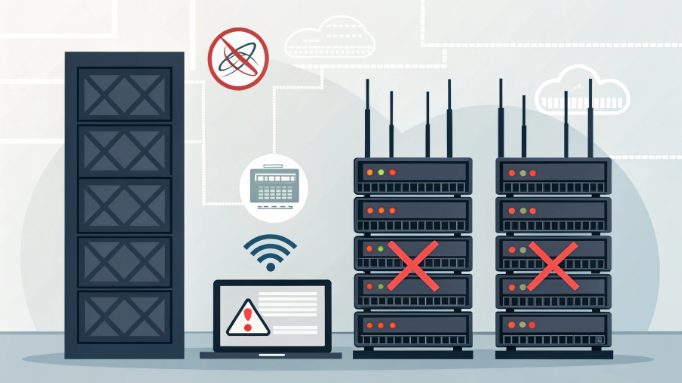Why Server IPs Get Blacklisted?

In the complex ecosystem of server management, IP blacklisting remains a critical challenge for system administrators and DevOps engineers, particularly in the Hong Kong hosting environment. Understanding the technical intricacies behind IP blacklisting is crucial for maintaining reliable server operations and preventing service disruptions. With the increasing sophistication of cyber threats, even well-maintained servers can fall victim to blacklisting, impacting business continuity and service reliability.
Technical Root Causes of IP Blacklisting
The blacklisting of server IPs often stems from multiple technical vectors that security systems flag as suspicious or malicious. Let’s analyze these vectors through a technical lens:
1. Email Server Misconfigurations
Email server issues represent one of the most common triggers for IP blacklisting. These technical misconfigurations can quickly lead to your IP address being flagged by major email providers and blacklist operators.
- Incorrectly configured PTR records leading to reverse DNS lookup failures
- Missing or invalid SPF/DKIM/DMARC records causing authentication failures
- Open relay configurations exposing servers to abuse
- Exceeded rate limits on SMTP connections triggering spam filters
- Improper mail queue management leading to backscatter
- Insufficient spam filtering allowing malicious content
2. Network Security Breaches
Security compromises often lead to automated blacklisting when malicious activities are detected. Common scenarios include:
- Port scanning activities from compromised systems indicating potential reconnaissance
- NTP amplification attack participation in DDoS campaigns
- SSH brute force attempts from your IP range
- Exploit attempts against known CVEs targeting vulnerable services
- Malware command and control traffic
- Unauthorized cryptocurrency mining operations
Advanced Detection and Monitoring
Implementing robust monitoring systems is essential for early detection of potential blacklisting triggers. A comprehensive monitoring strategy should incorporate multiple layers of detection:
Essential Monitoring Tools and Metrics
- Network Traffic Analysis:
- Wireshark for packet-level inspection
- NetFlow analysis for traffic patterns
- Deep packet inspection (DPI) tools
- Log Management:
- ELK Stack implementation for centralized logging
- Log correlation engines
- Custom alert rules for suspicious activities
- Email Metrics:
- Delivery rate monitoring
- Bounce rate analysis
- Spam complaint tracking
Prevention: Technical Implementation Guide
Preventing IP blacklisting requires a comprehensive technical approach that combines multiple security layers and best practices. Here’s a detailed breakdown of essential preventive measures:
1. Server Hardening Protocols
Implementing robust server hardening measures is your first line of defense against potential blacklisting triggers:
- Fail2ban Implementation:
- Custom jail configurations for specific services
- Progressive ban durations for repeat offenders
- IP whitelist management for trusted sources
- Custom filter patterns for application-specific attacks
- Firewall Configuration:
- Rate limiting rules for critical services
- Geographic IP blocking for high-risk regions
- Application-layer filtering
- Port access restrictions
- System Security:
- Regular security patch management
- Rootkit detection implementation
- File integrity monitoring
- Process accounting and auditing
2. Email Server Optimization
Email server configuration requires particular attention to prevent blacklisting. Implement these critical measures:
- MTA Configuration:
- Proper SMTP authentication settings
- TLS encryption for all connections
- Queue management optimization
- Resource utilization limits
- Authentication Protocols:
- SPF record implementation
- DKIM signing configuration
- DMARC policy setup
- Regular authentication testing
Recovery and Remediation Procedures
When blacklisting occurs, a systematic approach to recovery is essential. Follow these detailed technical steps:
Immediate Response Protocol
- Initial Assessment:
- Identify affected IP addresses
- Check multiple blacklist databases
- Document blacklist reasons
- Assess impact scope
- Security Audit:
- Full system scan for malware
- Network traffic analysis
- Log file investigation
- Configuration review
- Remediation Steps:
- Remove compromised components
- Update security configurations
- Patch vulnerable systems
- Implement additional security measures
Hong Kong Server Infrastructure Considerations
Operating servers in Hong Kong presents unique challenges and requirements that demand specific technical considerations:
- Regional Network Architecture:
- HKIX peering optimization
- Cross-border traffic routing
- Regional CDN integration
- Bandwidth management
- Compliance Requirements:
- Data privacy regulations
- Content delivery policies
- Cross-border data transfer rules
- Local hosting requirements
Best Practices for Long-term Prevention
To maintain a healthy IP reputation and prevent future blacklisting incidents, implement these comprehensive technical protocols:
- Automated Security Systems:
- Continuous vulnerability scanning
- Automated patch management
- Real-time threat detection
- Behavioral analysis systems
- Monitoring and Alerting:
- Custom monitoring dashboards
- Alert threshold configuration
- Incident response automation
- Performance metrics tracking
- Documentation and Procedures:
- Incident response playbooks
- Configuration management database
- Security policy documentation
- Change management procedures
Technical Maintenance Schedule
Implement a regular maintenance schedule that includes:
- Daily Tasks:
- Log analysis and review
- Backup verification
- Security alert checking
- Performance monitoring
- Weekly Tasks:
- Security patch evaluation
- System updates scheduling
- Configuration backup
- Resource usage analysis
- Monthly Tasks:
- Full security audit
- Performance optimization
- Policy review and updates
- Disaster recovery testing
Advanced Technical Considerations
For enterprise-level hosting environments, consider these additional technical measures:
- Infrastructure Resilience:
- Load balancer configuration
- Failover system setup
- High availability architecture
- Geographic redundancy
- Security Enhancements:
- Web application firewalls
- DDoS mitigation systems
- Zero-trust network architecture
- Advanced threat protection
Conclusion
Managing server IP reputation in Hong Kong’s hosting environment requires a delicate balance of technical expertise, proactive monitoring, and systematic maintenance. The key to preventing IP blacklisting lies in implementing comprehensive security measures while maintaining vigilant oversight of server operations. By following these technical guidelines and best practices, system administrators can significantly reduce the risk of IP blacklisting and maintain optimal server performance.
Key Takeaways
- Proactive monitoring is essential for early detection
- Multi-layered security approach provides best protection
- Regular maintenance prevents most blacklisting triggers
- Hong Kong-specific considerations require special attention
- Documentation and procedure standardization ensure consistency
Remember that server security and IP reputation management is an ongoing process that requires constant attention and updates to stay ahead of emerging threats in the hosting industry.

